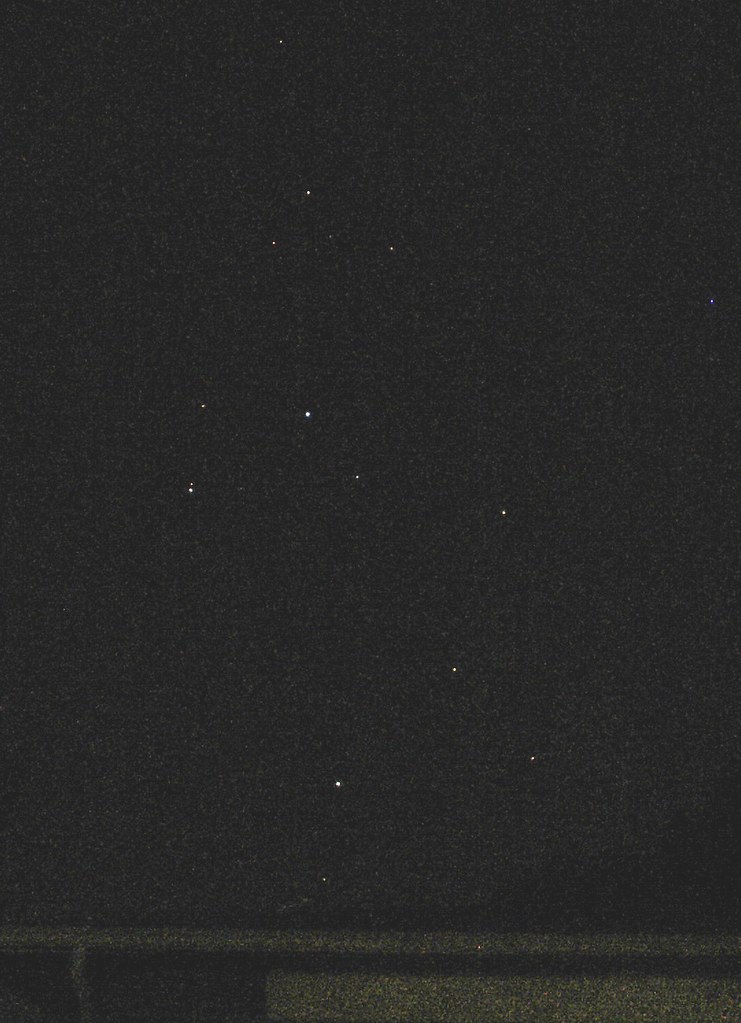Celestial Cuppa Tea, with Milky Way

Sagittarius was setting over my garage when I took this shot at 8:06 PM (EDT). My camera is not geared toward astrophotography -- I aimed blind through my viewfinder, took the shot using my maximum available aperture (2.8) and exposure (4 seconds), then increased brightness and contrast with some decrease in gamma to bring out the stars. Part of Sagittarius is best-known as the "Teapot," which I've labeled and outlined here. (Click the magnifying glass and then scroll right and down to read the text.)
When you look at this constellation, you're also looking toward the center of the Milky Way....
According to the National Audubon Society Field Guide to the Night Sky, "This is a large constellation that was probably first associated with Nergal, the arrow-shooting god of war, by Sumerian peoples of the Euphrates Valley. It was known by the Greeks as the archer, and later came to be identified as a satyr or centaur. There has been much debate over just who Sagittarius is, though it is generally agreed that he is a centaur -- half man, half horse.... It is difficult to recognize a centaur here, but a modern asterism called the Teapot is relatively easy to find within the larger constellation....Sagittarius lies in the same direction of the sky as our galaxy's center, and so the band of the Milky Way is brighest here."
I did volunteer work for five years in the planetarium field and gave shows, mostly to school children, narrating live. The shows included star and constellation ID, and I once made a blooper as I pointed out Sagittarius. As the field guide says, Sagittarius is most easily recognizable as a teapot, even though that's not what the ancients had in mind when they named it.
I told my audience, "This is Sagittarius, the Archer. Here is the handle, and here is the spout."
Tonight Mary and I took our walk under a chilly, beautifully clear sky. My camera can't catch the Milky Way but I could see it stretching overhead and could even see a bit of its Great Rift. As I stargazed I spotted the Okean O Rocket rising through Capricorn, and followed it until it faded away shortly after passing Cygnus. It's the brightest artificial satellite I've seen thus far. According to Heavens Above, tonight it was at magnitude 2.8. According to my old 1983 Observer's Handbook put out by the Royal Astronomical Society of Canada, that puts this satellite at the same visual magnitude as Kaus Borealis (λ Sagittarii) -- the star at the top of the "teapot" cover. (The teapot in this shot is angled down to the right, so it looks as though it's pouring onto my roof.)
Okean O (no longer active) was launched from Kazakhstan on July 17, 1999. Sponsored by the National Space Agency of Ukraine and to some extent by the Russian Space Agency, this satellite was part of a program to monitor ocean surfaces, measuring sea surface temperatures, wind speed, sea color, status of ice coverage, cloud coverage and precipitation. It follows a near-circular polar orbit. More information on the program is here. Some images sent by the satellite are here.











2 Comments:
"Tea with Milky Way" should be the name of a book or something. I really admire you and Mary's habit of taking walks and your interest in just about everything in the natural world.
Love that title! The night sky becomes a place of even greater mystery when seen through the eye of your camera and as expressed in your words. Saggitarius above the garage, indeed!
Post a Comment
<< Home